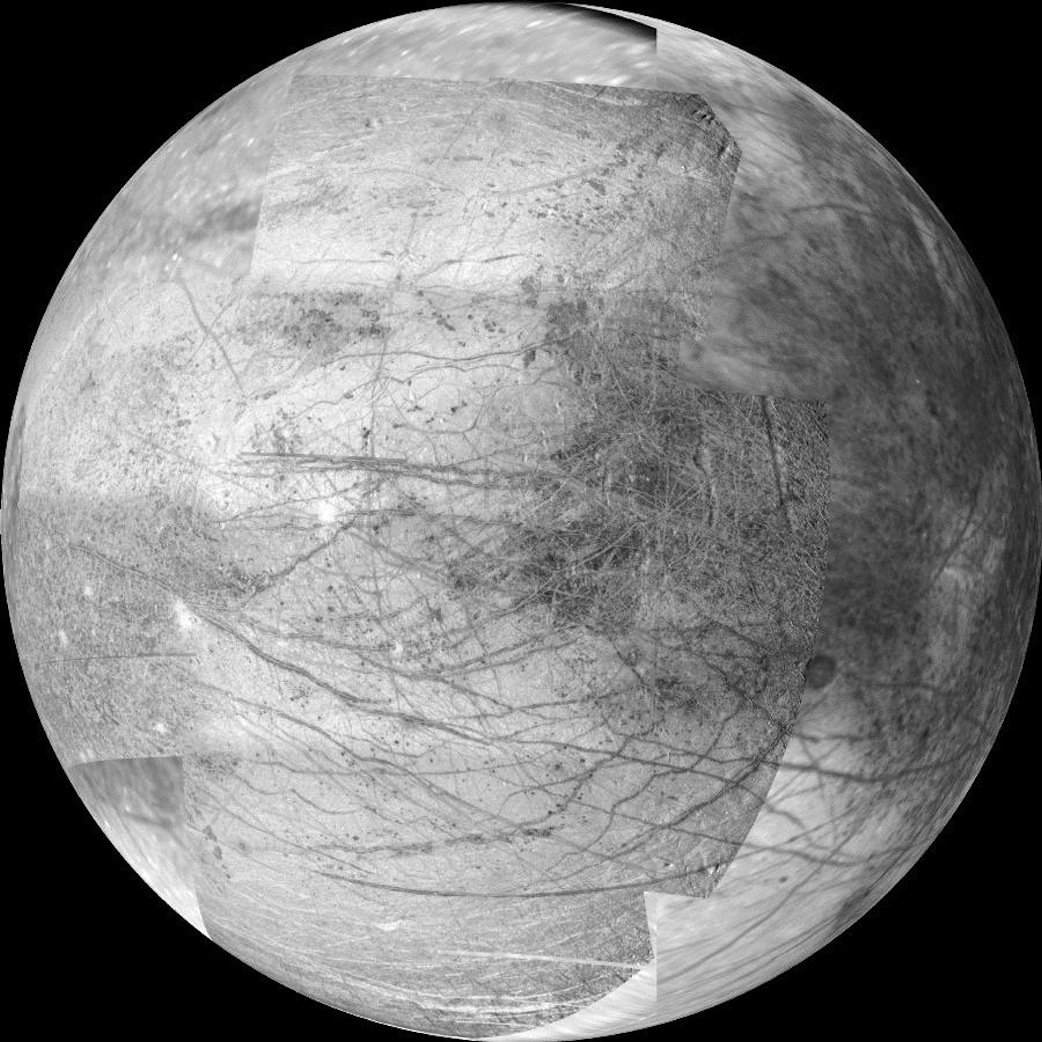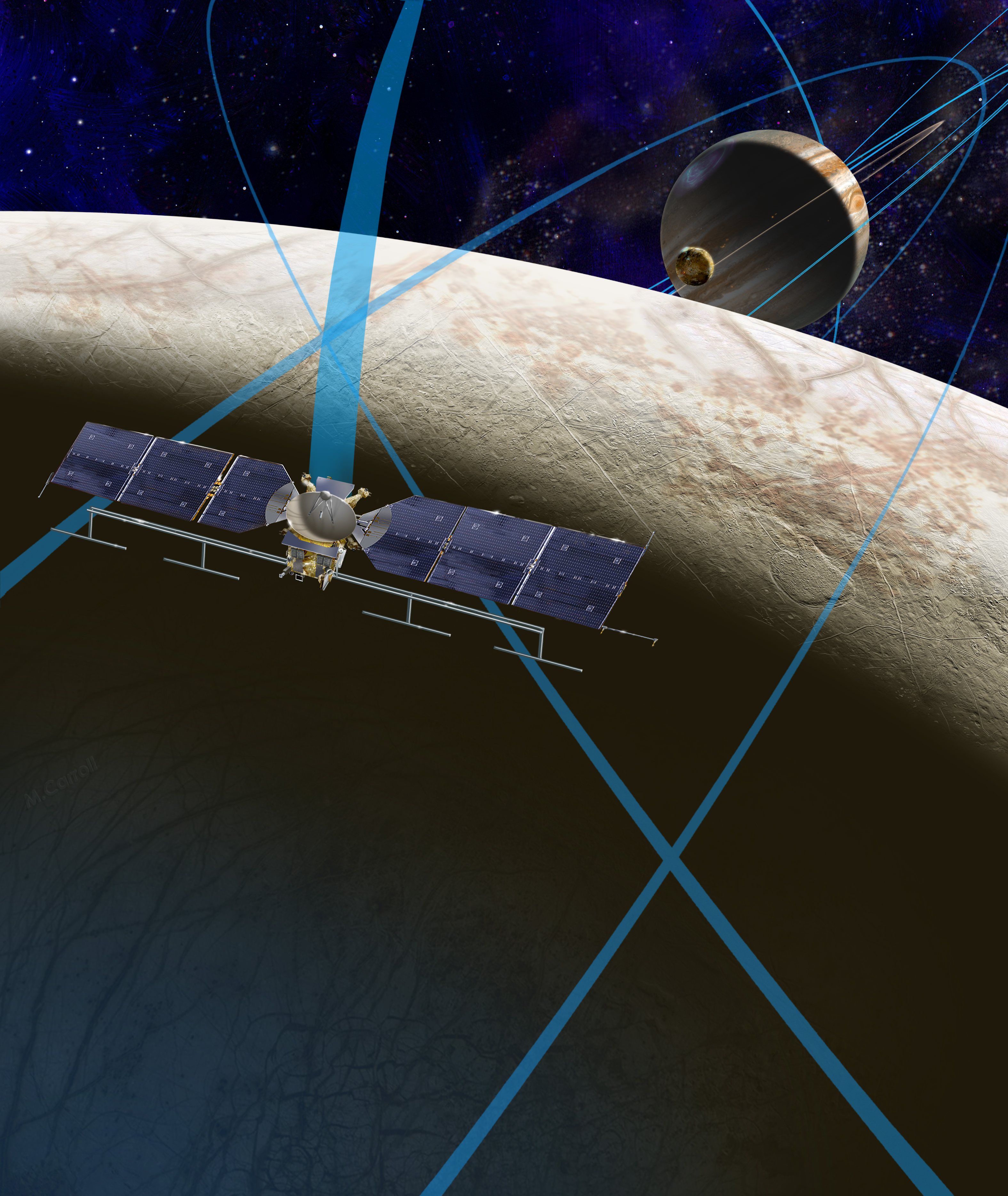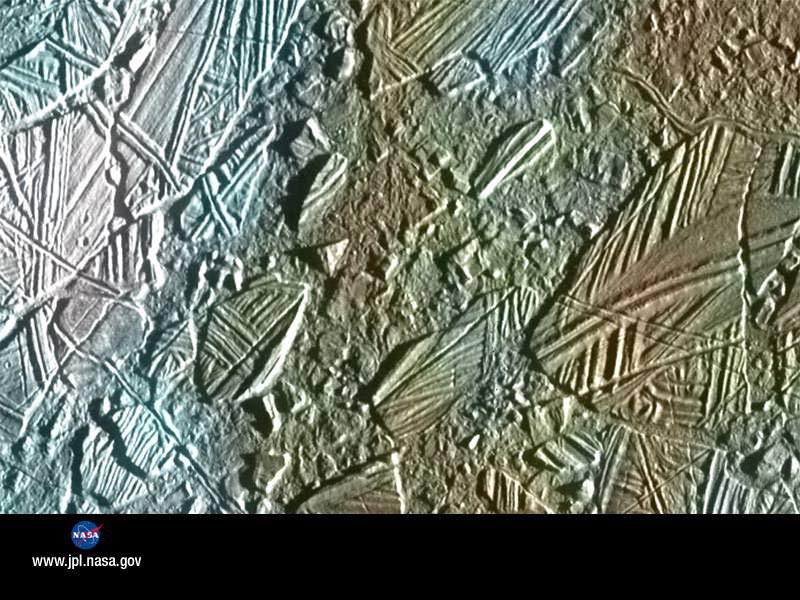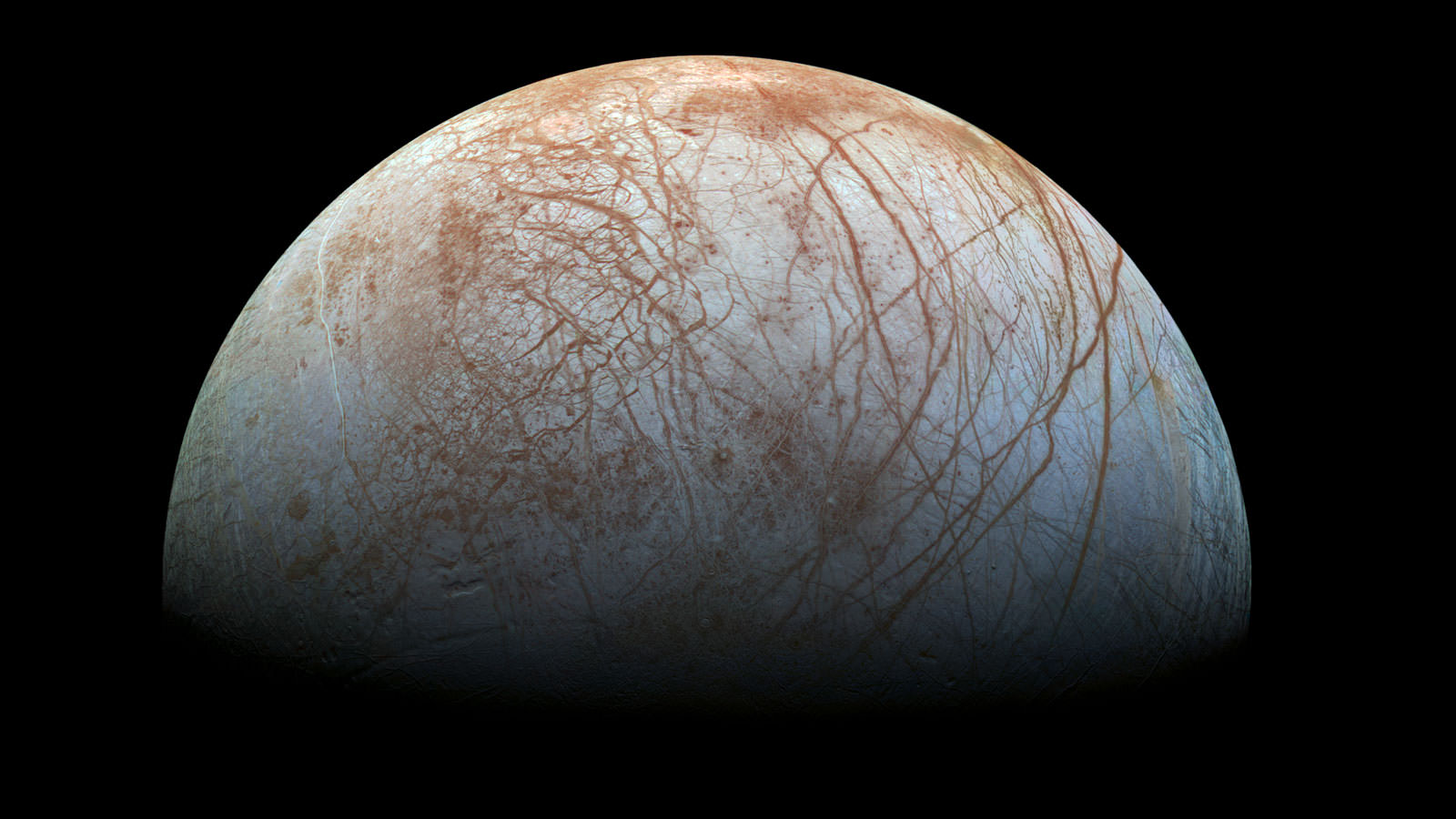In a major move forward on a long dreamed of mission to investigate the habitability of the subsurface ocean of Jupiter’s mysterious moon Europa, top NASA officials announced today, Tuesday, May 26, the selection of nine science instruments that will fly on the agency’s long awaited planetary science mission to an intriguing world that many scientists suspect could support life.
“We are on our way to Europa,” proclaimed John Grunsfeld, associate administrator for NASA’s Science Mission Directorate in Washington, at a media briefing today outlining NASA’s plans for a mission dedicated to launching in the early to mid-2020s. “It’s a mission to inspire.”
“We are trying to answer big questions. Are we alone?”
“The young surface seems to be in contact with an undersea ocean.”
The Europa mission goal is to investigate whether the tantalizing icy Jovian moon, similar in size to Earth’s moon, could harbor conditions suitable for the evolution and sustainability of life in the suspected ocean.
It will be equipped with high resolution cameras, radar and spectrometers, several generations beyond anything before to map the surface in unprecedented detail and determine the moon’s composition and subsurface character. And it will search for subsurface lakes and seek to sample erupting vapor plumes like those occurring today on Saturn’s tiny moon Enceladus.
“Europa has tantalized us with its enigmatic icy surface and evidence of a vast ocean, following the amazing data from 11 flybys of the Galileo spacecraft over a decade ago and recent Hubble observations suggesting plumes of water shooting out from the moon,” says Grunsfeld.
“We’re excited about the potential of this new mission and these instruments to unravel the mysteries of Europa in our quest to find evidence of life beyond Earth.”
Planetary scientists have long desired a speedy return on Europa, ever since the groundbreaking discoveries of NASA’s Galileo Jupiter orbiter in the 1990s showed that the alien world possessed a substantial and deep subsurface ocean beneath an icy shell that appears to interact with and alter the surface in recent times.

NASA’s Europa mission would blastoff perhaps as soon as 2022, depending on the budget allocation and rocket selection, whose candidates include the heavy lift Space Launch System (SLS).
The solar powered probe will go into orbit around Jupiter for a three year mission.
“The mission concept is that it will conduct multiple flyby’s of Europa,” said Jim Green. director, Planetary Science Division, NASA Headquarters, during the briefing.
“The purpose is to determine if Europa is a habitable place. It shows few craters, a brown gum on the surface and cracks where the subsurface meet the surface. There may be organics and nutrients among the discoloration at the surface.”
Europa is at or near the top of the list for most likely places in our solar system that could support life. Mars is also near the top of the list and currently being explored by a fleet of NASA robotic probes including surface rovers Curiosity and Opportunity.
“Europa is one of those critical areas where we believe that the environment is just perfect for potential development of life,” said Green. “This mission will be that step that helps us understand that environment and hopefully give us an indication of how habitable the environment could be.”
The exact thickness of Europa’s ice shell and extent of its subsurface ocean is not known.
The ice shell thickness has been inferred by some scientists to be perhaps only 5 to 10 kilometers thick based on data from Galileo, the Hubble Space Telescope, a Cassini flyby and other ground and space based observations.
The global ocean might be twice the volume of all of Earth’s water. Research indicates that it is salty, may possess organics, and has a rocky sea floor. Tidal heating from Jupiter could provide the energy for mixing and chemical reactions, supplemented by undersea volcanoes spewing heat and minerals to support living creatures, if they exist.

“Europa could be the best place in the solar system to look for present day life beyond our home planet,” says NASA officials.
The instruments chosen today by NASA will help answer the question of habitability, but they are not life detection instruments in and of themselves. That would require a follow on mission.
“They could find indications of life, but they’re not life detectors,” said Curt Niebur, Europa program scientist at NASA Headquarters in Washington. “We currently don’t even have consensus in the scientific community as to what we would measure that would tell everybody with confidence this thing you’re looking at is alive. Building a life detector is incredibly difficult.”
‘During the three year mission, the orbiter will conduct 45 close flyby’s of Europa,” Niebur told Universe Today. “These will occur about every two to three weeks.”
The close flyby’s will vary in altitude from 16 miles to 1,700 miles (25 kilometers to 2,700 kilometers).
“The mass spectrometer has a range of 1 to 2000 daltons, Niebur told me. “That’s a much wider range than Cassini. However there will be no means aboard to determine chirality.” The presence of Chiral compounds could be an indicator of life.
Right now the Europa mission is in the formulation stage with a budget of about $10 million this year and $30 Million in 2016. Over the next three years the mission concept will be defined.
The mission is expected to cost in the range of at least $2 Billion or more.

Here’s a NASA description of the 9 instruments selected:
Plasma Instrument for Magnetic Sounding (PIMS) — principal investigator Dr. Joseph Westlake of Johns Hopkins Applied Physics Laboratory (APL), Laurel, Maryland. This instrument works in conjunction with a magnetometer and is key to determining Europa’s ice shell thickness, ocean depth, and salinity by correcting the magnetic induction signal for plasma currents around Europa.
Interior Characterization of Europa using Magnetometry (ICEMAG) — principal investigator Dr. Carol Raymond of NASA’s Jet Propulsion Laboratory (JPL), Pasadena, California. This magnetometer will measure the magnetic field near Europa and – in conjunction with the PIMS instrument – infer the location, thickness and salinity of Europa’s subsurface ocean using multi-frequency electromagnetic sounding.
Mapping Imaging Spectrometer for Europa (MISE) — principal investigator Dr. Diana Blaney of JPL. This instrument will probe the composition of Europa, identifying and mapping the distributions of organics, salts, acid hydrates, water ice phases, and other materials to determine the habitability of Europa’s ocean.
Europa Imaging System (EIS) — principal investigator Dr. Elizabeth Turtle of APL. The wide and narrow angle cameras on this instrument will map most of Europa at 50 meter (164 foot) resolution, and will provide images of areas of Europa’s surface at up to 100 times higher resolution.
Radar for Europa Assessment and Sounding: Ocean to Near-surface (REASON) — principal investigator Dr. Donald Blankenship of the University of Texas, Austin. This dual-frequency ice penetrating radar instrument is designed to characterize and sound Europa’s icy crust from the near-surface to the ocean, revealing the hidden structure of Europa’s ice shell and potential water within.
Europa Thermal Emission Imaging System (E-THEMIS) — principal investigator Dr. Philip Christensen of Arizona State University, Tempe. This “heat detector” will provide high spatial resolution, multi-spectral thermal imaging of Europa to help detect active sites, such as potential vents erupting plumes of water into space.
MAss SPectrometer for Planetary EXploration/Europa (MASPEX) — principal investigator Dr. Jack (Hunter) Waite of the Southwest Research Institute (SwRI), San Antonio. This instrument will determine the composition of the surface and subsurface ocean by measuring Europa’s extremely tenuous atmosphere and any surface material ejected into space.
Ultraviolet Spectrograph/Europa (UVS) — principal investigator Dr. Kurt Retherford of SwRI. This instrument will adopt the same technique used by the Hubble Space Telescope to detect the likely presence of water plumes erupting from Europa’s surface. UVS will be able to detect small plumes and will provide valuable data about the composition and dynamics of the moon’s rarefied atmosphere.
SUrface Dust Mass Analyzer (SUDA) — principal investigator Dr. Sascha Kempf of the University of Colorado, Boulder. This instrument will measure the composition of small, solid particles ejected from Europa, providing the opportunity to directly sample the surface and potential plumes on low-altitude flybys.
Stay tuned here for Ken’s continuing Earth and planetary science and human spaceflight news.


Ohhh Babay!!! Bring on the Jovian Space Whales!!!
I predict an ocean of extremely corrosive acid.
See http://www.ncbi.nlm.nih.gov/pubmed/10506568
Wow! Everything thus far has, as far as I have noted, pointed to a tiny little Europa mission in the late 2030’s. But this is ambitious!
And best thing would be to skip the “life detector” since it will show that Europa too is a dead place, and then popular interest will vanish. Habitable environments is what should and is being search for, for statistical extrapolation once we know how life originated.
Worse than a, “watch me pee all over your parade” nay-sayer is a cocky, know-it-all one…
Do you wanna bet that there is life in Europa? I’m willing to bet against you. What probability are you ready to pay for? What do you really believe? What is your degree of understanding of reality? Give me a number!
You see, there’s a huge difference between habitable and inhabited. The inner ocean of Europa might be habitable for some microbes which have evolved on Earth. But that says nothing about how life could’ve originated in Europa. Says nothing about it being inhabited. When the parade marches by the toilette, they will smell the pee regardless of the weather. You don’t need to take my word for it. You could wait 20 years and trust the data from this probe, if you prefer that instead. Europa is dead from surface to core.
Well, we can trust the data from the probe…or trust you.
Which one will have first-hand information?
I and the probe will agree 100%. You don’t need to worry about that. But hey, it is exciting to explore an icy moon! This expedition, which now has some serious financing, political backing and a really good set of instruments, will give information about how habitable such kinds of worlds are. And if we somehow figure out how life can originate, then maybe we can conclude than one in a million or one in a thousand icy moons will likely have life. But those who expect a space frog in a plume out of Europa will only be sooo disappointed.
Why send a probe at all, when FALA already knows everything?
@mewo
Because it will do interesting science about icy moons!
Guys like you are exactly why the probe to Europa will be a disaster for robotic space exploration. Once it proves the obvious, that Europa is dead, guys like you who have no interest for science at all, but just dream about some sci fi movie coming true, will then ignore everything which has to do with spaceflight.
What are you on about? No interest in science? I’m not the one waving his hands, screaming “Don’t look! Don’t look!”
The fact is that *either* finding, life or no life, would be fascinating. If there is life elsewhere in the Solar System, then it indicates that the Universe might be teeming with it. If it turn out that Mars, Europa, Titan, Enceladus, etc, are all barren, despite having conditions where life could survive, then it implies that we are probably very rare or unique in the Universe- and that would be just as profound as learning life is common.
I don’t pretend to know whether life will be found there. You have no way of knowing either. You are just guessing, based on zero evidence and zero reasoning, but you pretend to know for sure. Just like you guessed to know anything about me, and you were 100% completely and utterly wrong. Give me a break.
You’re.
Not.
Fooling.
Anyone.
It is perfectly possible to reason about the low temperature, lack of energy and nutrients in the maybe existing ocean in Europa. Today’s unrealistic expectations will backlash. If alien life is detected one day, the public’s reaction will be: “I thought you did that decades ago. Aren’t you scientists supposed to discover something new?” A large fraction of people today actually believe that alien life has already been found. Especially that meteorite from Mars seems to have given this impression.
Anyway, looks like a great mission to the icy moon. And on the SLS it might get there in reasonable time too.
the first Ice world … up close and personal 🙂
Hello Europa
very nice and inspiring article.science has developed mush evrything
is possible in the world of science
professional essay writers uk
I am glad that we are sending a dedicated science mission to Europa. It should get there in my lifetime. I can’t help getting frustrated at the non-attempt of detecting life itself. I do understand that the definition of life is difficult and controversial. Europa, as I see and understand so far, is our best chance to find life. Finding life outside of Earth is one of the most exciting things I dream of. They mention a “follow on mission” to check for life, I’ll be long dead then. Pitty.
Because it is difficult to find alien life. Only a small fraction of the thousands of species of microbes which live inside ourselves have been studied, for example. One needs to take a sample back to the gigant labs on Earth in order to find out. And then some people fear that maybe that could spread disease to all life on Earth if the landing of the capsule fails and the quarantine is broken, which it maybe could, I have no idea. Diseases do exist, and all life on Earth is closely related, so one strike might wipe us all out and make Earth as barren as Mars. Maybe Mars is inhabited by a cosmic death bug? Maybe that is the explanation for why universe looks dead?
Since we don’t have any theory for how life originates, scientists look for what they do understand something about: habitability. Conditions where current Earth life could survive. It is easier to measure stuff like temperature, radiation, toxicity, nutrients.
One thing we know about Earth is that it completely transformed the planet. The atmosphere, the minerals, and even the magma from volcanoes contains evidence for the so called coal cycle which indicates presence of life. The traces of life as we know it are obvious and easy to find, and would be even long after it dies out. That’s not good news for the possibility of shy life hiding under some surface.